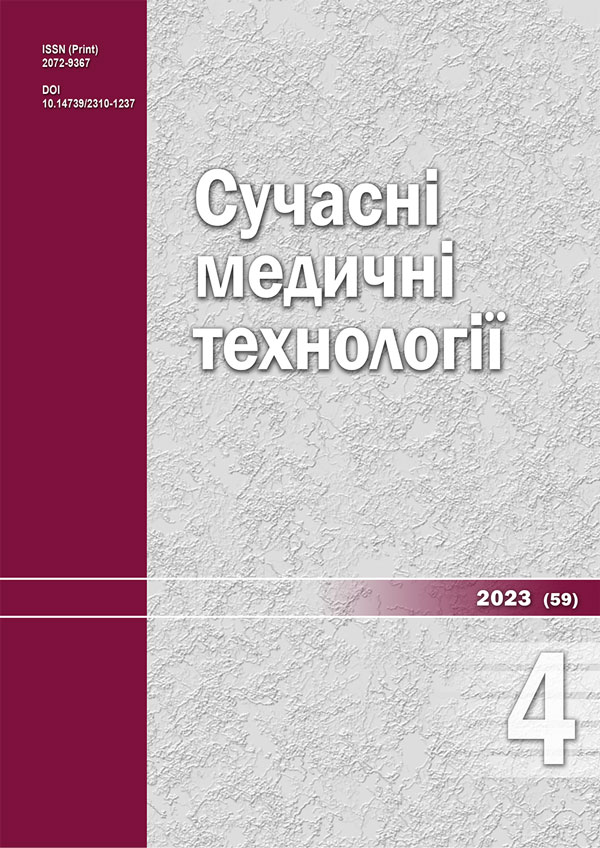Resonance frequency analysis – indicator of post-implantation morphology of mandibular bone tissue
DOI:
https://doi.org/10.34287/MMT.4(59).2023.9Abstract
This article describes the role of resonance frequency analysis (RFA) as an indicator of the quality of primary implant stability, which is the basis of the goal and confirmed by the results of a clinical case – odontological implantation on edentulous segments of atrophied bone tissue on the right side of the mandible, taking into account the topographic features of its canal, using ultra-short (h = 5.5 mm) implants.
Aim. To highlight the role of resonance frequency analysis during surgical interventions using short (ultrashort) implants in predicting their primary stability and preserving the normal morphology of the mandibular bone tissue.
Materials and methods. The primary stability of 17 dental implants in seven patients was determined using the Penguin Instruments (RFA) technique in declarative units of measurement – the implant stability quotient (ISQ). Values in the range of 75 ISQ meant that the implant had adequate primary stability and could receive and distribute the immediate load on the bone tissue of the edentulous segment.
Results. Following the stages of preparation, 17 ultra-short (h = 5.5 mm × b = 4.0 mm) implants were placed on the edentulous segments of the mandible without an incisional osteotomy path according to the patient rehabilitation protocol. We used the method of resonance frequency analysis to obtain a value of high primary stability of two short subcortical implants in the projection of tooth 4.7 – 92 ISQ and the projection of tooth 4.6 – 90 ISQ. On the 3rd day of the clinical stage of fixation of the supraconstruction, RFA measurements were performed, the values of which showed a significant decrease in the stability quotient of the installed implants in the projection of tooth 4.7 – 61 ISQ and in tooth 4.6 – 74 ISQ. This result made it necessary to revise the rehabilitation plan, adjust the medical prescription sheet and decide to postpone the placement of the all-milled restorative structure on the implants.
Conclusions. The RFA study indicates not only the primary stability of implants but also a full-fledged stage-bystage clinical prognosis of the further functionality of a prosthetic structure based on short implants with proper preservation of the morphological functionality of bone tissue.
References
Kim SY, Ku JK, Kim HS, Yun PY, Kim YK. A retrospective clinical study of single short implants (less than 8 mm) in posterior edentulous areas. J Adv Prosthodont. 2018;10(3):191-6. doi: 10.4047/jap.2018.10.3.191
Loskutov OY, Shponka IS, Bondarenko OO, Bondarenko NS, Bozhko AG. Histological and histochemical assessment of short-term events in peri-implant bone for osteoinductivity evaluation of functional-protective implant coatings. Medychni perspektyvy. 2021;26(3):4-10. doi: 10.26641/2307- 0404.2021.3.241875
Dharmapala RMAU, Satharasinghe DM, Silva SPI, Jeyasugiththan J. Medical Physics Determination of safe zone of the mandible for implant and bone harvesting (using CBCT) of mandible in a group of Sri Lankan subjects. Journal of the National Science Foundation of Sri Lanka, 2022;50(1):65-72. doi: 10.4038/jnsfsr.v50i1.10485
Oshurko AP, Oliinyk IYu, Kuzniak NB. Morphological significance of bone atrophy for topographic features of the left mandibular canal. World of Medicine and Biology. 2021;(4):131-5. doi: 10.26724/2079-8334-2021-4-78-131-135
Testori T, Clauser T, Scaini R, Wang HL, Del Fabbro M. Long-Term Results of Intraforaminal Immediately Loaded Implants and Posterior Mandibular Regrowth Evaluation in Severely Atrophic Mandibles. Int J Oral Maxillofac Implants. 2022;37(1):199-207. doi: 10.11607/jomi.9077
Ewers R, Marincola M, Perpetuini P, Morina A, Bergamo ETP, Cheng YC, et al. Severely Atrophic Mandibles Restored With Fiber-Reinforced Composite Prostheses Supported by 5.0-mm Ultra-Short Implants Present High Survival Rates Up To Eight Years. J Oral Maxillofac Surg. 2022;80(1):81-92. doi: 10.1016/j.joms.2021.09.018
Amato F, Polara G, Spedicato GA. Immediate Loading of Fixed Partial Dental Prostheses on Extra-Short and Short Implants in Patients with Severe Atrophy of the Posterior Maxilla or Mandible: An Up-to-4-year Clinical Study. Int J Oral Maxillofac Implants. 2020;35(3):607-15. doi: 10.11607/jomi.7943
Fastovets OO, Sapalov SO, Shtepa VO. [Results of stress-strain states study in prosthetics of different types of atrophy of edentulous mandible]. Medychni perspektyvy. 2020;25(4):146-58. (Ukrainian). doi: 10.26641/2307- 0404.2020.4.221411
Bouchard AL, Dsouza Ch, Julien С, Rummler М, Gaumond M-H, Cermakian N, et al. Bone adaptation to mechanical loading in mice is affected by circadian rhythms. Bone. 2022;(154):116218. doi: 10.1016/j.bone.2021.116218
Yamada Y, Nakamura-Yamada S, Miki M, Nakajimaa Y, Babaa S. Trends in clinical trials on bone regeneration in dentistry-towards an innovative development in dental implant treatment. J. of Oral Science & Rehabilitation. 2019;5(4):8-17. Available from: https://www.dtscience.com/wp-content/ uploads/2020/01/
Mangano FG, Admakin O, Lerner H, Mangano C. Artificial intelligence and augmented reality for guided implant surgery planning: A proof of concept. J Dent. 2023;133:104485. doi: 10.1016/j.jdent.2023.104485
Talmazov G, Bencharit S, Waldrop TC, Ammoun R. Accuracy of Implant Placement Position Using Nondental Open-Source Software: An In Vitro Study. Journal of Prosthodontics. 2020;29(7):604-10. doi: 10.1111/ jopr.13208
Chen J, Bai X, Ding Y, Shen L, Sun X, Cao R, et al. Comparison the accuracy of a novel implant robot surgery and dynamic navigation system in dental implant surgery: an in vitro pilot study. BMC Oral Health. 2023;23(1):179. doi: 10.1186/s12903-023-02873-8
Adams CR, Ammoun R, Deeb GR, Bencharit S. Influence of Metal Guide Sleeves on the Accuracy and Precision of Dental Implant Placement Using Guided Implant Surgery: An In Vitro Study. J Prosthodont. 2023;32(1):62-70. doi: 10.1111/jopr.13503
Abduo J, Lau D. Seating accuracy of implant immediate provisional prostheses fabricated by digital workflow prior to implant placement by fully guided static computer-assisted implant surgery: An in vitro study. Clin Oral Implants Res. 2021;32(5):608-18. doi: 10.1111/clr.13731
Downloads
Published
How to Cite
Issue
Section
License
The work is provided under the terms of the Public Offer and of Creative Commons Attribution-NonCommercial 4.0 International (CC BY-NC 4.0). This license allows an unlimited number of persons to reproduce and share the Licensed Material in all media and formats. Any use of the Licensed Material shall contain an identification of its Creator(s) and must be for non-commercial purposes only.














